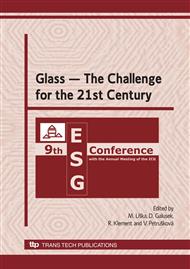p.641
p.647
p.653
p.659
p.663
p.667
p.671
p.675
p.679
Structure and Properties of 137Cs Containing Waste Glass
Abstract:
Vitrification has been recognized as the best method of the neutralization and immobilization of the radioactive and toxic wastes. Toxic elements are introduced into the structure of chemically durable glasses (waste glasses). Radioactive 137Cs is a dangerous contaminant of hospital and laboratory wastes. Incineration of these waste followed by vitrification of the ashes by co-melting them with borosilicate glass is a prospective method of immobilization of 137Cs for safety waste storage. The influence of partial substitution of Na by Cs and introduction of CaO as the main component of the hospital waste incineration ash on the structure, crystallization ability, and physical properties of SiO2-B2O3 -Al2O3-Na2O glass was studied. It was established that due to crystallochemical differences between Cs+ and Na+ as the glass structure modifiers, in the presence of even a relatively small amount of Cs2O (5 mass %) the degree of polymerization of the glass network and its stability increases which means, simultaneously the increase of the chemical durability of the glass. On the other hand above glass transformation temperature (Tg), cesium acts as the strong depolymeriser of network, increasing the tendency for crystallization of the basic glass. It becomes incorporated into the structure of the newly formed crystal phases such as the chemically resistant aluminosilicates (pollucite, nepheline).
Info:
Periodical:
Pages:
671-674
Citation:
Online since:
April 2008
Authors:
Price:
Сopyright:
© 2008 Trans Tech Publications Ltd. All Rights Reserved
Share:
Citation:


